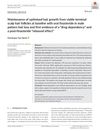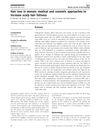Androgenetic Alopecia
February 2014
in “
PubMed
”
androgenetic alopecia AGA dehydrotestosterone DHT androgen-sensitive hair follicles hair diameter hair length hair pigmentation diffuse thinning crown region frontal hairline hyperandrogenism bitemporal recession vertex scalp dermoscopy topical minoxidil antiandrogen agents 5-alpha reductase inhibitors androgenic alopecia hair follicles hair thickness hair color thinning hair crown hairline high androgen levels receding hairline top of the head scalp examination Rogaine antiandrogens 5-AR inhibitors

TLDR Androgenetic alopecia is a common hair loss condition caused by testosterone effects on hair follicles, leading to thinner, shorter, and less pigmented hair, diagnosed using scalp dermoscopy and treated with topical minoxidil, antiandrogen agents, and 5-alpha reductase inhibitors.
Androgenetic alopecia (AGA) is the most common form of hair loss, affecting up to 80% of men and 50% of women during their lifetime. It is caused by the effects of the testosterone metabolite dehydrotestosterone (DHT) on androgen-sensitive hair follicles, leading to a progressive reduction in hair diameter, length, and pigmentation. In women, AGA often results in diffuse thinning of the crown region while maintaining the frontal hairline, and in premenopausal women, it can be a sign of hyperandrogenism. Men typically experience bitemporal recession of the frontal hairline, followed by diffuse thinning at the vertex. Scalp dermoscopy is used to diagnose and monitor AGA, and treatments include topical minoxidil, antiandrogen agents, and 5-alpha reductase inhibitors. AGA is a progressive disease that tends to worsen over time.





